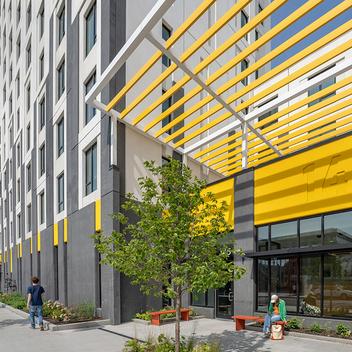In this episode, Phil Thomas, Wells Corporate Engineering Trainer, covers helpful information on designing with precast beams and how you can utilize them in the design of your structure.
Beams play an important role in transferring heavy floor loads to their column supports and are critical to the overall load path of a structure. The topics covered in this video include:
- Types of beams
- Preliminary selection of beams
- Design of beams for external loads and manufacturing considerations
Types of beams.
Precast beams can be produced in all different shapes and sizes. Beams can support not only precast elements, but many other types of construction as well.
- Inverted tee beams are a common element in precast construction. They can support double tees, flat slabs, beams or other floor members on either side of the beam. Inverted tee beams have integral ledges that carry the other floor members, allowing them to be erected quickly and easily.
- L-beams are similar to inverted tee beams but they primarily support other floor members on one side only.
- R-beams can support surrounding building systems on either side but do not contain an integral ledge. This can be achieved in many ways through pockets or embed plates with welded steel supports.
Preliminary selection of beams for your structure.
The preliminary selection of beams is best achieved by referencing the load tables provided in the latest edition of the PCI manual. The load tables make it easy for Engineers and Architects to understand which beam sections are most economical given a desired span length and floor loading. Understanding the overall structural depth requirements early will help maximize floor to ceiling heights and mechanical coordination.
Design of beams for external loads and manufacturing considerations.
Precast beams typically have a minimum release strength of 3500psi and a 5000psi final strength. They typically function as girder elements and therefore collect a tremendous amount of load. Because of this, they can be quite a bit beefier than other floor members as they can have very large end reactions to go along with very large spans. Shear reinforcement at the end of members generally results in the use of closed stirrups or mesh ladders. The main flexural reinforcements are pre-stressed strands located at the bottom of the beam. Pre-stressing strands create internal compression forces that counteract the tension experienced at the bottom of the beam under load.
Beams are typically manufactured in steel forms that can be anywhere from 100 to 600 feet in length for larger Bridge sections. They can be produced in a variety of depths and widths that vary widely among manufacturers. Lifting devices are cast in so that they can be stripped from their forms and safely handled until they are placed into their final positions within the structure. Transportation constraints such as weight and overall length should be considered early in the project timeline to avoid any issues later.
Overall precast beams are an important and high-quality product to consider when designing a given structure.
Additional Beam Resources:
Find these resources in our Design Handbook:
- Precast Beam Specifications
- Beam Bearing Details
Don't be shy about reaching out to Wells or your local supplier to find out if precast is the right solution for your project.



